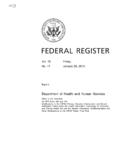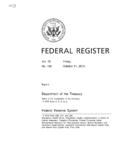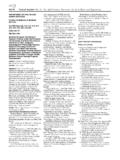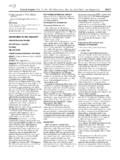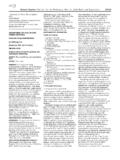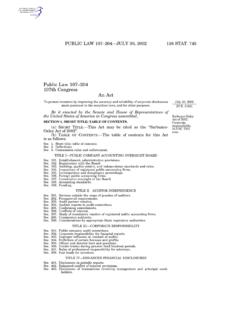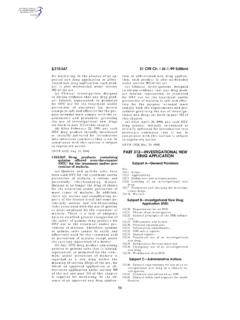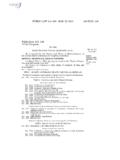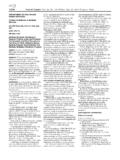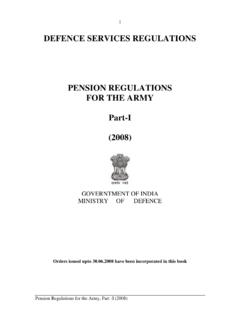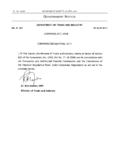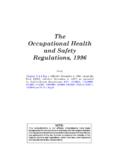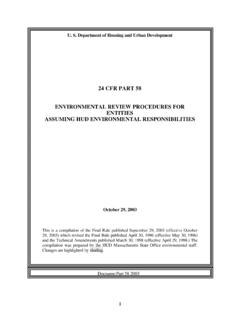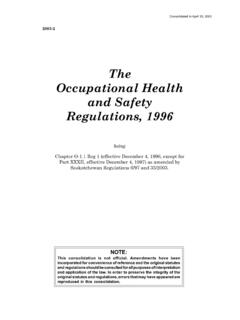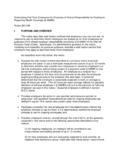Transcription of §61.140 40 CFR Ch. I (7–1–11 Edition)
1 98 40 CFR Ch. I (7 1 11 Edition) (C) The date of each determination of the maximum concentration point, as described in (h), and a brief rea-son for the determination. (ii) For each vapor incinerator, the date and duration of each exceedance of the boundary parameters recorded under (i)(6) and a brief descrip-tion of the corrective action taken. (iii) For each vapor incinerator, the date and duration of each period speci-fied as follows: (A) Each period recorded under (i)(7)(i) when the vent stream is diverted from the control device or has no flow rate; (B) Each period recorded under (i)(7)(ii) when the vent stream is diverted from the control device; and (C) Each period recorded under (i)(7)(iii) when the vent stream is diverted from the control device, when the car seal is broken, when the valve is unlocked, or when the valve position has changed.
2 (iv) For each vapor incinerator, the owner or operator shall specify the method of monitoring chosen under paragraph (f)(2) of this section in the first semiannual report. Any time the owner or operator changes that choice, he shall specify the change in the first semiannual report following the change. [56 FR 47407, Sept. 19, 1991, as amended at 64 FR 7467, Feb. 12, 1999; 65 FR 62157, Oct. 17, 2000] Subpart M National Emission Standard for Asbestos AUTHORITY: 42 7401, 7412, 7414, 7416, 7601. SOURCE: 49 FR 13661, Apr. 5, 1984, unless otherwise noted. Applicability. The provisions of this subpart are ap-plicable to those sources specified in through , , and [55 FR 48414, Nov.]
3 20, 1990] Definitions. All terms that are used in this sub-part and are not defined below are given the same meaning as in the Act and in subpart A of this part. Active waste disposal site means any disposal site other than an inactive site. Adequately wet means sufficiently mix or penetrate with liquid to prevent the release of particulates. If visible emissions are observed coming from as-bestos-containing material, then that material has not been adequately wetted. However, the absence of visible emissions is not sufficient evidence of being adequately wet. Asbestos means the asbestiform vari-eties of serpentinite (chrysotile), riebeckite (crocidolite), cummingtonite-grunerite, anthophyllite, and actinolite- tremolite.
4 Asbestos-containing waste materials means mill tailings or any waste that contains commercial asbestos and is generated by a source subject to the provisions of this subpart. This term includes filters from control devices, friable asbestos waste material, and bags or other similar packaging con-taminated with commercial asbestos. As applied to demolition and renova-tion operations, this term also includes regulated asbestos-containing material waste and materials contaminated with asbestos including disposable equipment and clothing. Asbestos mill means any facility en-gaged in converting, or in any inter-mediate step in converting, asbestos ore into commercial asbestos.
5 Outside storage of asbestos material is not con-sidered a part of the asbestos mill. Asbestos tailings means any solid waste that contains asbestos and is a product of asbestos mining or milling operations. Asbestos waste from control devices means any waste material that con-tains asbestos and is collected by a pol-lution control device. Category I nonfriable asbestos-con-taining material (ACM) means asbestos- containing packings, gaskets, resilient floor covering, and asphalt roofing products containing more than 1 per-cent asbestos as determined using the method specified in appendix E, sub-part E, 40 CFR part 763, section 1, Po-larized Light Microscopy.
6 VerDate Mar<15>2010 14:27 Aug 04, 2011 Jkt 223151 PO 00000 Frm 00108 Fmt 8010 Sfmt 8010 Y:\SGML\ 223151erowe on DSK5 CLS3C1 PROD with CFR99 Environmental Protection Agency Category II nonfriable ACM means any material, excluding Category I nonfri-able ACM, containing more than 1 per-cent asbestos as determined using the methods specified in appendix E, sub-part E, 40 CFR part 763, section 1, Po-larized Light Microscopy that, when dry, cannot be crumbled, pulverized, or reduced to powder by hand pressure. Commercial asbestos means any mate-rial containing asbestos that is ex-tracted from ore and has value because of its asbestos content.
7 Cutting means to penetrate with a sharp-edged instrument and includes sawing, but does not include shearing, slicing, or punching. Demolition means the wrecking or taking out of any load-supporting structural member of a facility to-gether with any related handling oper-ations or the intentional burning of any facility. Emergency renovation operation means a renovation operation that was not planned but results from a sudden, un-expected event that, if not imme-diately attended to, presents a safety or public health hazard, is necessary to protect equipment from damage, or is necessary to avoid imposing an unrea-sonable financial burden.
8 This term in-cludes operations necessitated by non-routine failures of equipment. Fabricating means any processing ( , cutting, sawing, drilling) of a manufactured product that contains commercial asbestos, with the excep-tion of processing at temporary sites (field fabricating) for the construction or restoration of facilities. In the case of friction products, fabricating in-cludes bonding, debonding, grinding, sawing, drilling, or other similar oper-ations performed as part of fabricating. Facility means any institutional, commercial, public, industrial, or resi-dential structure, installation, or building (including any structure, in-stallation, or building containing con-dominiums or individual dwelling units operated as a residential cooperative, but excluding residential buildings having four or fewer dwelling units); any ship; and any active or inactive waste disposal site.
9 For purposes of this definition, any building, structure, or installation that contains a loft used as a dwelling is not considered a residential structure, installation, or building. Any structure, installation or building that was previously subject to this subpart is not excluded, regardless of its current use or function. Facility component means any part of a facility including equipment. Friable asbestos material means any material containing more than 1 per-cent asbestos as determined using the method specified in appendix E, sub-part E, 40 CFR part 763, section 1, Po-larized Light Microscopy, that, when dry, can be crumbled, pulverized, or re-duced to powder by hand pressure.
10 If the asbestos content is less than 10 per-cent as determined by a method other than point counting by polarized light microscopy (PLM), verify the asbestos content by point counting using PLM. Fugitive source means any source of emissions not controlled by an air pol-lution control device. Glove bag means a sealed compart-ment with attached inner gloves used for the handling of asbestos-containing materials. Properly installed and used, glove bags provide a small work area enclosure typically used for small-scale asbestos stripping operations. Informa-tion on glove-bag installation, equip-ment and supplies, and work practices is contained in the Occupational Safety and Health Administration s (OSHA s) final rule on occupational exposure to asbestos (appendix G to 29 CFR ).
